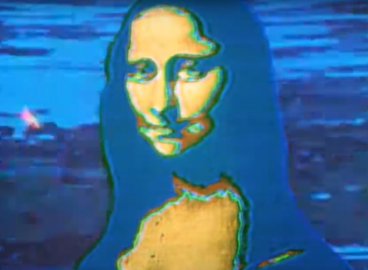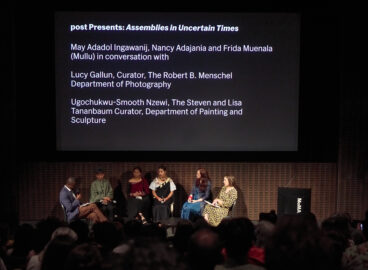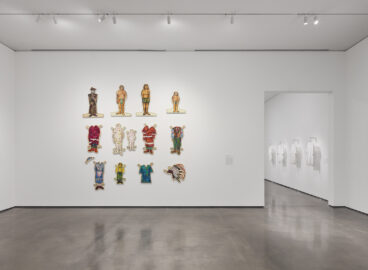A few remarks about MoMA’s research project “Contemporary and Modern Art Perspectives in a Global Age.”
Mieke Bal delivered this text as a response during the yearly C-MAP seminar that took place at The Museum of Modern Art in April 2013. Entitled “Global Networks,” this two-day long meeting of members of the three geographically oriented C-MAP research groups and guests focused on self-critically addressing C-MAP’s mission to build a more global program for MoMA’s exhibitions, publications, education, and collection—a program that would engage with the multiplicity of modernities and histories of contemporary and modern art. Members of the seminar discussed methodologies of researching region-specific networks in relation to art created in the mid-to-late 20th century, as well as the contemporary networks of scholars, institutions, and artists whose joint efforts result in the production and dissemination of knowledge about the former. Mieke Bal’s response sums up various conceptual threads that were developed in these conversations.
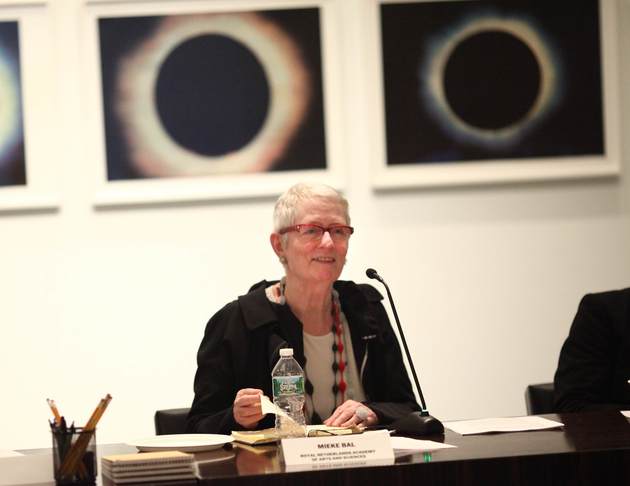
There is a great danger in calling art after modernism “contemporary.” The reason we do this, I think, is that after what Arthur Danto, Hans Belting, and others have called “the end of art,” there is no unified conception of art. Going back to the 1970s is not enough, for that was precisely an end of sorts. Because each art object is the outcome of a practice, it is also contemporary with its time.
In the Western world, “art” has become a concept in a development usually seen as beginning in the 14th century, theorized and historicized by Vasari in the 16th, and, according to art historians such as Danto and Belting, declared to have ended in the 1960s or ’70s. The alleged development was, according to Ernst Gombrich, an ongoing attempt to perfect realistic depiction, so that realism became the standard by which one judged art. With modernism, Clement Greenberg, instead, promoted purity, defined as medium specificity. Then, after modernism, art ended. Plurality was the new norm, and so the clear criterion by which to judge art vanished. And with it, the connoisseur. Plurality and the lack of criteria—not the lack of quality, but the end of our arrogance to think we can judge it—are behind the despair elicited by the predicament of globalization.
Suspiciously, this end of art coincided with the official end of colonialism. Purity had definitively been compromised, and so the plurality that replaced the coherent concept of art was easily transformed into a renewed, equally imperial search for art elsewhere, in parts of the world where equally thriving image cultures that had not bothered with restrictive concepts of art now became hunting grounds for art workers. Equally suspiciously, when new nations emerged, the idea of “nation” became obsolete. Meanwhile, postcolonial theorists, many of them leading feminist thinkers, asked new questions and offered new concepts that helped us understand the new, but somehow also old, cultural scene that later came to be called “global.” Such questions bear upon the issue of cultural homogeneity, which had always been an untenable idea; the different temporalities in different places; the cultural attitudes that Homi K. Bhabha has analyzed as “mimicry,” through which resistance and adaptation can be enacted together, and many more issues that undermine our abilities to either judge or ignore the art of other cultures. Those are the questions we are better off listening to and trying to answer—to learn from them.
Contemporary is the historical condition of all art when we see it as the outcome of a practice. To use the word for the purpose of periodization is a hopelessly progressivist idea. If set in a chronology, after the contemporary there is nothing, which would mean that we are, indeed, at the end of art. Instead, I think the concept of contemporaneity is extremely important to indicate a relationship between art and social practice. We cannot, can never, know how the contemporariness of art from the past really worked, and with the modesty of the no-expert, acknowledging this limit of what we can know is a first step toward the possibility of comparison. And this, a transhistorical comparison, begins with the acknowledgement of the necessity of anachronism. The paradox is this: to pursue a faithful reconstruction of the past is by definition an anachronistic endeavor because it omits the art’s principled contemporaneity.
With this qualification of the project of history writing, we are better equipped to address the contemporaneities of both the past and the present and to establish an exchange with the past. Instead of reconstructing an insular past falsely considered objective, we can bring it to bear on the present, and vice versa.
A careful reading of its name reveals that what is contemporary about C-MAP is not the art – although some of it may be – but the perspectives (plural!) that we bring to modern art. It is important to keep in sight the potential contribution of anachronism in writing the history of modern art, and, in relation to this, the importance of the meaning of the C in C-MAP.
In relation to these perspectives, I want to propose four areas where our collective thoughts can be deepened, and I offer beginnings for that process below. These areas are a breadth-depth tension; the question of what to do in the face of the impossibility of being comprehensive; the conception of art through the notion of movement; and the meaning of the frequent recurrence of the word “political.”
Comparison
For the breadth-depth tension, I propose comparison.1This concept was originally proposed by Jodi Hauptman during the C-MAP seminar. Comparison is a tool used to reconcile the irreconcilable; it helps create a gap, and then bridge it. In other words, it allows us to be aware of the great gaps that divide the world and of the gaps in our knowledge—in time, in geography, in social circumstances. Comparison requires a common element that binds the compared elements. In the case of Latin American conceptualism, for example, that common ground would be conceptualism, obviously, but also something else.2Ana Longoni’s C-MAP seminar presentation entitled “Southern Conceptualism Network. Achievements and Challenges” brought this out with clarity. Let’s call this, for now, the political. I’ll return to that. The best comparison, then, would bring conceptualism and its political charge together across a gap to be defined—of time or of geography, or, I can imagine, a gap between North and South, so that comparison becomes possible without incommensurability and without erasure of differences, but on the contrary, as a means of seeing differences more clearly and bond on the basis of these.
The one-to-one comparison is a way of preserving depth but need not be the only mode of comparing. I can imagine that, after doing some of such dual comparisons one can broaden the scope of it, and slowly add elements to it. That would be a timid, careful, form of “expansion” (to use a tricky word), without the risk of facile accumulation. This would result, after a while, in an incipient network.
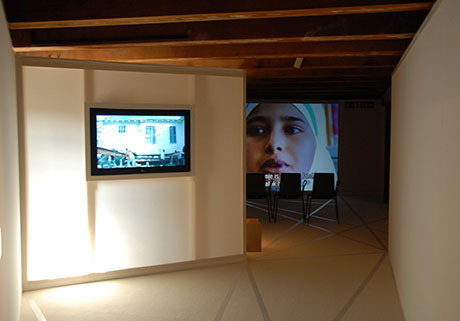
In my own curatorial work, I have tried to push comparison as far as possible with the exhibition 2MOVE, a collaborative project with the Spanish art historian, novelist, and poet Miguel Á. Hernández Navarro. The project consisted of a traveling exhibition and two encuentros (workshops). We co-curated this show in several countries, in close collaboration with the local curators. Each site added a few works by local artists, some recently arrived, some not. With the concept we sought to establish a productive crossing-over, in other words, a comparison, between the notion of the moving image as an artistic medium particularly widespread today and the currently highly visible fact that people move. The ground for comparison was simply movement. In the exhibition we explored the various ways video and migration could be brought to bear on each other outside the realm of an over-politicized and anachronistically general view of migration as a social phenomenon of today.
Comprehensiveness
Being comprehensive is impossible, and I don’t think it is desirable. As I hinted, the desire for comprehensiveness carried over willy-nilly by the idea of expansion has an imperialist flavor to it. The attempt to broaden the scope and to break the unification of the history of modern art does need some crossing of unreflectively endorsed boundaries, but for me the metaphor would be exchange rather than expansion. Information is not the same as knowledge. To transform information into knowledge, we need to pursue insight, in a kind of “second-personhood,” and also keep an eye on relevance.
Being the institution it is, MoMA, with its history and collections, cannot give up its identity, but it can break open the unreflected assumptions that structure it, and that is what C-MAP is doing. It so happens that the collections have made three regions—Latin America, East Asia, and Central and Eastern Europe—the primary targets of this project, each specialized in a form, medium, and practice of modern art. Sometimes this feels like a limitation; but then, that is also the condition of that desired depth of analysis. There is no reason not to bring into the comparison an artist, practice, or tradition, even, of places other than the three collection-driven regional foci. But a focus there must be. What matters in the opening up we are pursuing with C-MAP is to change under the impact of the questions that come in from the outside, in the exchange. An open ear to those questions, which are perhaps at first sight incongruous, coming from different interests, with different agendas and burdened by different histories, will help change something at MoMA from within, with conviction. That is the beauty of exchange. So, the alternative word for expansion is simply exchange.
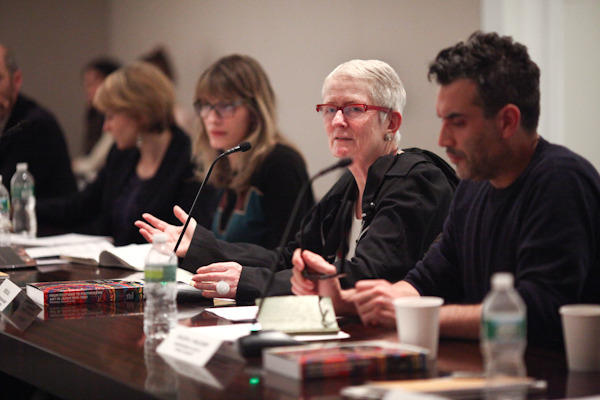
The nation state is neither gone nor to be wished away.3These remarks are a response to Homi Bhabha’s contribution to the C-MAP seminar. Nevertheless, art is not always made, processed, seen, relevant, in a national context. In the contemporary world, it can be best understood through such concepts as migratory aesthetics and the fundamental movement of art, and the traps of an exoticizing, condescending view of it, as well as a kind of cultural schizophrenia or cultural autism avoided in favor of exchange.
The conversation seems to be moving away from the art object and towards practices. I think it is important to notice and continue this, but I hesitate before the binary implied. A museum is, among other things, a guardian of objects that are irreplaceable, if only because at some point in history they have been considered so. That history is part of the object. And each of these objects is the outcome of a practice. The interest in practices does not have to preclude the interest in returning regularly to contemplate the objects. The objects are the remaining result of the practices, and the invitation to new practices (of looking, thinking, changing).
One form of comparison that becomes possible with this in mind is the acquisition of an object that on some ground of comparison can be considered an interlocutor of one of the objects already in the collection. This is, de facto, the reason for acquisitions. Spelling out some of the grounds of the comparison and the results of it, the conclusions concerning the object already in the collection and the one newly acquired, is a pathway to the insights we seek to acquire into the broader, I dare not say global but at least transnational, meaning of art and what it can achieve in the world.
Movement
That the exhibition 2MOVE was focused on video as a moving art form was just a way of drawing attention to the potential of a conceptualization of migratory aesthetics in terms, primarily, of movement as the common element—the ground of comparison—between the two parts of the phrase “migratory aesthetics.” This focus enabled us to move freely between the literal sense of movement—as in the moving image and the movement of people—and all the connotations, allusions, and underlying metaphorical meanings the word harbors. This includes emotional movement: the movement of the heart, of the senses, and of the intelligence, as a consequence of an encounter (inter-). This moving quality is activated in space and mediates effects that are not bound to the traditional ways of making meaning or seeing art.
My favorite example of moving art, in all meanings of the qualifier, are the sculptures of Colombian artist Doris Salcedo, who relentlessly indicts political violence and its erasure in collective memory. Her sculptures are still, yet they move. I submit that art moves in all possible ways, and therefore can be the emblematic field, or object, for contemplating alternative approaches to art, different from boundary policing and fixation of categories.
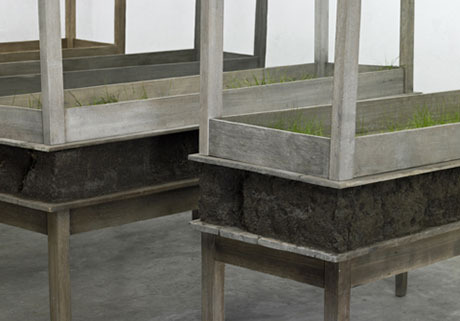
Art can have an impact on the world, because art moves. Let me abbreviate and simplify a complex argument. French philosopher Henri Bergson suggests, first, that living in duration is a form of gathering: each moment is accompanied by the memory of preceding ones, not necessarily in the chronological or causal order of their occurrence. Perception, second, involves both the materiality of objects and of the human body. Bergson considers the body to be a material entity, and consequently he sees perception as a material practice. Given his insistence on the inseparability of time and space, the image is also in movement by definition. It is material not because of the support we associate with images, but because the bodily action of mobilizing the image is material. Hence, “still” images also move.
Bergson’s thinking adds a third movement, inherent in perception. This knot of three movements implies that the image itself—not its support—is both moving and material. It means it is plural and functional—it does something. We can call it performative (as in performativity). Exhibitions, where, unlike cinema and painting, the visitor is compelled to both focalize and move are the exemplary spaces where this fundamental movement is, in turn, embodied and performed.
One more movement linked to Bergson’s concept is key to the political force I seek to articulate as a precondition of what we might call intercultural curating. In 1907, the philosopher coined the term “creative evolution” to describe this type of movement. It occurs when understanding and action are imbricated. Without such an understanding we would be powerless to effect change, and art would be politically impotent. This fourth Bergsonian movement, the readiness to act, lies at the heart of the political potential of exhibitions. In the slowed-down temporality of an exhibition, this readiness can emerge and be nurtured.
Performance, conceptualism or abstraction, and Fluxus-based art are all capable of performativity. That performative force, as philosophers of language call it, is perhaps a possible new way of considering value. In this sense, the three areas selected as C-MAP’s focus are not simply collection-driven but are also typical of new possibilities.
The Political
I would like to propose some remarks about the frequent use of the word “political.” This speaks to me, so much so that I have just finished a project of several years on the question of political art: in three volumes, on three “mediums,” through the work of three artists. Through the work of Doris Salcedo, I have examined the political potential of “still” sculpture. Through the video work of Eija-Liisa Ahtila, I have theorized the political force of video installation as an art form. And with Ann Veronica Janssens’s “interventionist” installations, I have tried to tackle the difficult question of the political force of abstract art. All three books concern the relationship between artwork, viewer, and space.4Mieke Bal, Of What One Cannot Speak: Doris Salcedo’s Political Art (Chicago: University of Chicago Press, 2011); Thinking in Film: The Politics of Video Installation According to Eija-Liisa Ahtila (London: Blooomsbury, 2013); Endless Andness: The Politics of Abstraction According to Ann Veronica Janssens (London: Bloomsbury, 2013).
But I am weary of a certain thematic imposition on art. To phrase it a bit paradoxically, art is political, I contend, to the extent that it is not about politics. Art is indeed political by definition and specifically, in many cases, because it is “in the world.” To allude to Wittgenstein’s definition of “the world” as “what is the case,” I would say what is the case, in the world, is what art is part of, as well as what art addresses and can contribute to changing. In this admittedly broad sense, all art, it seems, partakes of the political. This generalization does not hold, however. Only some works of art address their participation in the political and make the political part of what they do. This is the kind of art we call “political”: it works not only in but with and for “the political.”
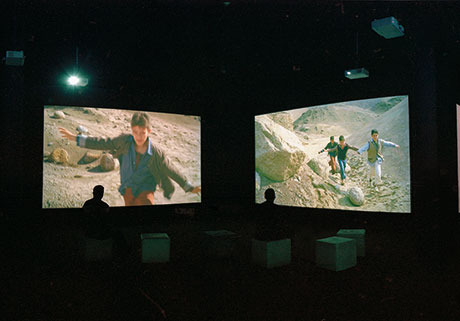
Again I am going to simplify and abbreviate a complex argument. The term “the political” as I use it here is understandable only in distinction from “politics.” Although both belong to the domain where social life is structured and governed, these two terms are each other’s opposite. In a concise book about this distinction, Belgian political theorist Chantal Mouffe defines the two terms as follows:
… by “the political” I mean the dimension of antagonism which I take to be constitutive of human societies, while by “politics” I mean the set of practices and institutions through which an order is created, organizing human coexistence in the context of conflictuality provided by the political.5Chantal Mouffe, On the Political (London: Routledge, 2005), p. 9.
“The dimension of antagonism”: at first glance, that does not sound very appealing. We tend to dislike or even fear antagonism. According to Mouffe’s definition, politics is the organization that settles conflict; the political is where conflict “happens.” Yet, it is by virtue of the political that social life is possible. It can thrive, be alive, and also be dangerous. No wonder, then, that we usually seek to avoid conflict by means of consensus. Politics comes in to avert the potential of danger. Responding to this potential, politics constantly attempts to dampen the political. This positive view of conflict might sound counterintuitive. And true enough, in our own social environment, we avoid conflict. Yet, as Mouffe cogently argues, the culture of consensus resulting from politics does not eliminate conflict; it suppresses conflict, and thus leaves it to its own underground, and hence potentially volcanic, devices. Politics is in fact highly exclusivist and lives by “the negation of the ineradicable character of antagonism.” It is also in blatant contradiction to the lived social reality, in which conflict is generally present.
French philosopher Jacques Rancière also argues in favor of the conflictual nature of social life and the need to disagree. Rancière uses the term mésentente to describe this conflictual element of social reality. This is an untranslatable word that combines misunderstanding with not getting along. Unfortunately, it is unilaterally translated as “disagreement.” The misunderstanding part is, however, just as crucial.
Mouffe continues her presentation of the two antagonistic domains of politics and the political with reference to an area of real conflict in contemporary societies:
… the dominant tendency in liberal thought is characterized by a rationalist and individualist approach which forecloses acknowledging the nature of collective identities. This kind of liberalism is unable to adequately grasp the pluralistic nature of the social world, with the conflicts that pluralism entails; conflict for which no rational solution could ever exist.6Mouffe, p. 10.
Paradoxically, then, individualism, which takes multiplicity as its starting point, is unable to deal with the actual plural nature of the social world. The hypostasis of individual freedom is in fact a severe limitation of multiplicity. The repression of group identities in the name of the individual makes for an easy slide from individualism to consensus, or worse, dictatorship.
Between “particularity,” and its underlying individualism, voyeurism, and anecdotal irrelevance, on the one hand, and “generality,” with its erasure of specificity on the other, I believe the term “singularity” is better suited to stay attuned to the common ground as well as to the gaps in our comparisons. I find that term most apt to account responsibly for the elements of multiplicity without either erasing or hyperbolically and defensively hypostatizing group identity. I understand singularity in a relation of opposition to generality in order to acknowledge and focus on the strictly irreducible differences between people and what happens to them. Art is the epitome of singularity. Through working with, contemplating, and considering art, we can be schooled in seeing, respecting, and valuing singularity. At the same time, this distinctiveness is not reducible to anecdotal information. Instead, the singular is that which maintains difference without turning it into the (generalizable) ground for group identity. And needless to say, art is the epitome of singularity. The political is allied with both the possibility of conflict and with the powers, structures, and choices that constitute the field of possibilities for action.
Conclusion
I started with an explanation of why the qualifier “contemporary” must not be used as a period indication. My plea for an unabashed endorsement of anachronism is related to this. Allow me to end with a personal experience. In 2010, my colleague Michelle Williams Gamaker and I experimented with the idea of anachronism to foreground the contemporaneity of art in general. We did this in an art installation for the Guggenheim Museum in Bilbao, where an exhibition of seventeenth-century art from the Städel in Frankfurt was mounted in the postmodern architecture of Frank Gehry. This seemingly incongruous combination, a clash between the art and its temporary environment, compelled the staff to commission from us a “video essay” on this question. We called our installation Anacronismos. The installation began with the juxtaposition of Jan Vermeer’s Geographer and a moving image of two individuals today, both images of people looking out into the world. The installation explored visual continuities and discontinuities through the past four centuries. In a play of still and moving images, paintings from the Golden Age exhibition were combined with moving images so that they appear merged, confronted, or confused, in anachronisms that are both productive and “mad.” Thus, past visions haunt the present, but also the present recasts the past.
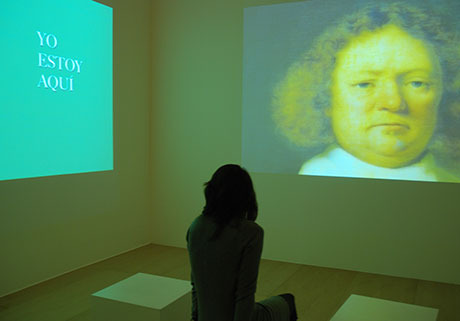
To understand anachronism and its potential to comment critically on such ideological tenets as nationalism, linguistic imperialism, and xenophobia, our work suggested we must first understand and acknowledge the devastating effects of unreflected anachronism—the good historian’s nemesis. Such unreflected anachronisms project the present onto the past; they flatten time. They confuse our conceptions of art with irrelevant considerations; they abuse art for the promotion of trivial interests, or at the very least, they take art out of its context of practice and thus make it transcendent.
Instead, we attempted to analyze through visual experiment how anachronisms can invigorate our interactions with historical objects by means of at least four different responses to the past in relation to the present, all responses where the contemporary viewer actively engages the old artwork: clash, continuation, projection, or reversal. Not that the anachronism is self-consciously performed in all these cases. But the question of how the past image can “fit” into present concerns, and conversely, how the contemporary image can cast new light on the past image without enforcing such relations as always continuous or similarity-based, once posed, can be tremendously helpful.
To work with anachronism, we must rethink the contemporary. There is no more compelling call for such reconsideration than Walter Benjamin’s statement, in his “Theses on the Philosophy of History,” that “every image of the past that is not recogni-zed by the present as one of its own concerns threatens to disappear irretrievably.”7Walter Benjamin, “Theses on the Philosophy of History” in Illuminations, ed. Hannah Arendt, trans. Harry Zohn (New York: Schocken), p. 255.
This is a strong plea for anachronism, including comparison. If it is not identified as relevant for our time, the image will disappear. Since extinction is forever, according to the well-known ecological slogan, the question that needs to be raised could be phrased as follows: how can art prevent the extinction of the past so that the present can make it matter for itself? First of all, through images of it: images that represent the past, that come to us from the past, and that make the past matter for the present. Those are the three meanings of the preposition “of” that resonate in Benjamin’s sentence. The operative verb in his urgent warning is “to recognize.”
The images of the past must be recognized—and recognized in their relevance for the present—so that we can effectively bring them to bear on the present. The penalty for failing to do so is the irretrievable loss not simply of the past but of its images, and hence, also of the three forms of relevance that the preposition “of” suggests they possess. The two meanings of recognition, one cognitive—to know again—and one social—to give acknowledgement to, to recognize something “as”—are bound up together. In both senses, recognition pertains to the dialectic of similarity, or repetition, and of difference or innovation that constitutes comparison. Through comparison, images from the past can move us in the present and thus compel the political agency as I have described it above. Hence, anachronism, comparison, movement, and the political go together in an insoluble bond of engagement with art that constitutes art’s lasting importance.
- 1This concept was originally proposed by Jodi Hauptman during the C-MAP seminar.
- 2Ana Longoni’s C-MAP seminar presentation entitled “Southern Conceptualism Network. Achievements and Challenges” brought this out with clarity.
- 3These remarks are a response to Homi Bhabha’s contribution to the C-MAP seminar.
- 4Mieke Bal, Of What One Cannot Speak: Doris Salcedo’s Political Art (Chicago: University of Chicago Press, 2011); Thinking in Film: The Politics of Video Installation According to Eija-Liisa Ahtila (London: Blooomsbury, 2013); Endless Andness: The Politics of Abstraction According to Ann Veronica Janssens (London: Bloomsbury, 2013).
- 5Chantal Mouffe, On the Political (London: Routledge, 2005), p. 9.
- 6Mouffe, p. 10.
- 7Walter Benjamin, “Theses on the Philosophy of History” in Illuminations, ed. Hannah Arendt, trans. Harry Zohn (New York: Schocken), p. 255.


